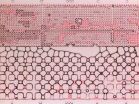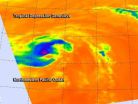(Press-News.org) HOUSTON – (Aug. 12, 2014) – A Rice University laboratory has provided proof that foam may be the right stuff to maximize enhanced oil recovery (EOR).
In tests, foam pumped into an experimental rig that mimicked the flow paths deep underground proved better at removing oil from formations with low permeability than common techniques involving water, gas, surfactants or combinations of the three.
The open-access paper led by Rice scientists Sibani Lisa Biswal and George Hirasaki was published online today by the Royal Society of Chemistry journal Lab on a Chip.
Oil rarely sits in a pool underground waiting to be pumped out to energy-hungry surface dwellers. Often, it lives in formations of rock and sand and hides in small cracks and crevices that have proved devilishly difficult to tap. Drillers pump various substances downhole to loosen and either push or carry oil to the surface.
Biswal's lab has learned a great deal about how foam forms. Now, with an eye toward EOR, she and her colleagues created microfluidic models of formations -- they look something like children's ant farms -- to see how well foam stacks up against other materials in removing as much oil as possible.
The formations are not much bigger than a postage stamp and include wide channels, large cracks and small cracks. By pushing various fluids, including foam, into test formations, the researchers can visualize the ways by which foam is able to remove oil from hard-to-reach places. They can also measure the fluid's pressure gradient to see how it changes as it navigates the landscape.
The team determined the numbers are strongly in foam's favor. Foam dislodged all but 25.1 percent of oil from low-permeability regions after four minutes of pushing it through a test rig, versus 53 percent for water and gas and 98.3 percent for water flooding; this demonstrated efficient use of injected fluid with foam to recover oil.
The less-viscous fluids appear to displace oil in high-permeability regions while blowing right by the smaller cracks that retain their treasure. But foam offers mobility control, which means a higher resistance to flow near large pores.
"The foam's lamellae (the borders between individual bubbles) add extra resistance to the flow," said Biswal, an associate professor of chemical and biomolecular engineering. "Water and gas don't have that ability, so it's easy for them to find paths of least resistance and move straight through. Because foam acts like a more viscous fluid, it's better able to plug high-permeable regions and penetrate into less-permeable regions."
Charles Conn, a Rice graduate student and lead author of the paper, said foam tends to dry out as it progresses through the model. "The bubbles don't actually break. It's more that the liquid drains away and leaves them behind," he said.
Drying has two effects: It slows the progress of the foam even further and allows surfactant from the lamellae to drain into low-permeability zones, where it forces oil out. Foam may also cut the sheer amount of material that may have to be sent downhole.
One of the challenges will always be to get the foam to the underground formation intact. "It's nice to know that foam can do these things, but if you can't generate foam in the reservoir, then it's not going to be useful," Conn said. "If you lose the foam, it collapses into slugs of gas and liquid. You really want foam that can regenerate as it moves through the pores."
INFORMATION:
The lab plans to test foam on core samples that more closely mimic the environment underground, Biswal said.
Kun Ma, a Rice alumnus, co-authored the paper. The Department of Energy, the Abu Dhabi National Oil Co., the Abu Dhabi Oil R&D Sub-Committee, the Abu Dhabi Co. for Onshore Oil Operations, the Zakum Development Co., the Abu Dhabi Marine Operating Co. and the Petroleum Institute of the United Arab Emirates supported the research.
Read the abstract at http://pubs.rsc.org/en/content/articlelanding/2014/lc/c4lc00620h#!divAbstract
Watch a video of foam pushing oil out of a microfluidic formation here: http://youtu.be/UfMTOvNuf28
This news release can be found online at http://news.rice.edu/2014/08/12/foam-favorable-for-oil-extraction/
Follow Rice News and Media Relations via Twitter @RiceUNews
Related Materials:
Biswal Lab: http://www.ruf.rice.edu/~biswalab/Biswal_Research_Group/Welcome.html
George R. Brown School of Engineering: http://engr.rice.edu
Images for download:
http://news.rice.edu/wp-content/uploads/2014/08/0804_FOAM-1-WEB.jpg
Foam sent through a microfluidic model created at Rice University shows its ability to remove oil (pink) from low-permeability formations. Rice scientists conducted experiments to see how foam would compare with water, gas or combinations of the two for use in enhanced oil recovery. (Credit: Biswal Lab/Rice University)
http://news.rice.edu/wp-content/uploads/2014/08/0804_FOAM-2-WEB.jpg
When water was sent through a microfluidic model created at Rice University to mimic underground reservoirs, it took the path of least resistance through wide channels while leaving oil in smaller channels untouched. The lab was comparing water, gas and foam for their usefulness in enhanced oil recovery. (Credit: Biswal Lab/Rice University)
Located on a 300-acre forested campus in Houston, Rice University is consistently ranked among the nation's top 20 universities by U.S. News & World Report. Rice has highly respected schools of Architecture, Business, Continuing Studies, Engineering, Humanities, Music, Natural Sciences and Social Sciences and is home to the Baker Institute for Public Policy. With 3,920 undergraduates and 2,567 graduate students, Rice's undergraduate student-to-faculty ratio is just over 6-to-1. Its residential college system builds close-knit communities and lifelong friendships, just one reason why Rice has been ranked No. 1 for best quality of life multiple times by the Princeton Review and No. 2 for "best value" among private universities by Kiplinger's Personal Finance. To read "What they're saying about Rice," go here.
David Ruth
713-348-6327
david@rice.edu
Mike Williams
713-348-6728
mikewilliams@rice.edu
Foam favorable for oil extraction
Rice University experiments visualize methods for enhanced recovery from wells
2014-08-12
ELSE PRESS RELEASES FROM THIS DATE:
Decline in daily functioning related to decreased brain activity in Alzheimer's
2014-08-12
Boston, MA – Decline in daily functioning associated with Alzheimer's disease is related to alterations in activity in certain regions of the brain, according to a study published in the August 2014 issue of the Journal of Alzheimer's Disease.
Impairment in instrumental activities of daily living—or an inability to perform high-level daily activities such as calculating finances, remembering appointments and medications, and driving—is first seen when a person has mild cognitive impairment, which can later progress to dementia due to Alzheimer's disease. Deterioration ...
Immigrants at lower risk of overdose, death from codeine than people born in Canada
2014-08-12
TORONTO, Aug. 12, 2014—Immigrants are at lower risk of an overdose or death after being prescribed codeine than people born in Canada, a new study has found.
Surprisingly, this is true even when the immigrants lack proficiency in English or French, which might be thought to hamper their ability to read prescription labels or instructions, said lead author Dr. Joel Ray, a physician and researcher at St. Michael's Hospital.
His study was published in the current issue of the Journal of Epidemiology and Community Health.
Dr. Ray undertook this study because of the large ...
Beating childhood cancer does not make survivors healthier adults
2014-08-12
Having survived cancer as a child does not necessarily have a ripple effect that makes people lead a healthier lifestyle once they grow up. In fact, in a report derived from a National Cancer Institute-funded study of childhood cancer survivors known as the Chicago Healthy Living Study, investigators found that childhood cancer survivors in no way adhere more closely to guidelines on healthy eating than their cancer-free peers. The findings are published in Springer's Journal of Cancer Survivorship.
Childhood cancer survivors face different health-care challenges and ...
Contrary to popular belief, more exercise is not always better
2014-08-12
Rochester, MN, August 12, 2014 – There is strong epidemiological evidence of the importance of regular physical activity, such as brisk walking and jogging, in the management and rehabilitation of cardiovascular disease and in lowering the risk of death from other diseases such as hypertension, stroke, and type 2 diabetes. The Physical Activity Guidelines for Americans recommends about 150 minutes per week of moderate-intensity exercise or about 75 minutes of vigorous-intensity exercise. But there is clear evidence of an increase in cardiovascular deaths in heart attack ...
Climate relicts may help researchers understand climate change
2014-08-12
While hiking through the Ozarks' characteristic oak and hickory forests as a teenager, ecologist Scott Woolbright discovered something decidedly uncharacteristic for the region: prickly pear cacti growing on an exposed, rocky ledge.
In a recent paper published in Trends in Ecology and Evolution, Woolbright describes how populations and communities like these, known as climate relicts, can help scientists understand how ecological communities are affected by climate change.
Rocky, well-drained slopes in the Ozarks often create habitat "islands" within the surrounding ...
NASA sees the end of Tropical Depression Genevieve
2014-08-12
Cloud tops were warming and precipitation was waning in Tropical Depression Genevieve when NASA's Aqua satellite flew overhead. Genevieve moved through all three Pacific Ocean regions (eastern, central and western) in its two week lifetime and met its end today.
NASA's Aqua satellite passed over Tropical Depression Genevieve on Aug. 11 at 01:29 UTC and the Atmospheric Infrared Sounder (AIRS) captured infrared data on the storm. AIRS data showed a small area of the strongest thunderstorms were occurring over the northern quadrant, where temperatures approached -63F/-52C. ...
Roadside research from the pinelands and coast to coast
2014-08-12
PHILADELPHIA (August 12, 2014)— "Roads are essentially the primary feature of human civilization at this point," according to Dane Ward, a doctoral student in environmental science at Drexel University who is presenting research at the Ecological Society of America (ESA) meeting.
Perhaps not surprisingly, Ward, along with fellow doctoral students Ryan Rebozo and Kevin P.W. Smith from the Laboratory of Pinelands Research led by Walter Bien, PhD in Drexel's College of Arts and Sciences, took advantage of a cross-country roadtrip from Philadelphia to the meeting in Sacramento ...
UMN and NYBC research finds potential MERS transmission mechanism between bats and humans
2014-08-12
Researchers have identified the mechanism used by the deadly MERS virus to transmit from bats to humans. Bats are a native reservoir for MERS and the finding could be critical for understanding the animal origins of the virus, as well as preventing and controlling the spread of MERS and related viruses in humans.
The findings were published in the most recent edition of the Proceedings of the National Academy of Sciences.
Leading the research was Fang Li, Ph.D., associate professor of Pharmacology at the University of Minnesota Medical School. Graduate students Yang ...
Notre Dame paper offers insights into a new class of semiconducting materials
2014-08-12
A new paper by University of Notre Dame researchers describes their investigations of the fundamental optical properties of a new class of semiconducting materials known as organic-inorganic "hybrid" perovskites.
The research was conducted at the Notre Dame Radiation Laboratory by Joseph Manser, a doctoral student in chemical and biomolecular engineering, under the direction of Prashant Kamat, Rev. John A. Zahm Professor of Science. The findings appear in a paper in the August 10 edition of the journal Nature Photonics.
The term "perovskites" refers to the structural ...
New analysis reveals tumor weaknesses
2014-08-12
CAMBRIDGE, Mass-- Scientists have known for decades that cancer can be caused by genetic mutations, but more recently they have discovered that chemical modifications of a gene can also contribute to cancer. These alterations, known as epigenetic modifications, control whether a gene is turned on or off.
Analyzing these modifications can provide important clues to the type of tumor a patient has, and how it will respond to different drugs. For example, patients with glioblastoma, a type of brain tumor, respond well to a certain class of drugs known as alkylating agents ...
LAST 30 PRESS RELEASES:
When tropical oceans were oxygen oases
Positive interactions dominate among marine microbes, six-year study reveals
Safeguarding the Winter Olympics-Paralympics against climate change
Most would recommend RSV immunizations for older and pregnant people
Donated blood has a shelf life. A new test tracks how it's aging
Stroke during pregnancy, postpartum associated with more illness, job status later
American Meteorological Society announces new executive director
People with “binge-watching addiction” are more likely to be lonely
Wild potato follows a path to domestication in the American Southwest
General climate advocacy ad campaign received more public engagement compared to more-tailored ad campaign promoting sustainable fashion
Medical LLMs may show real-world potential in identifying individuals with major depressive disorder using WhatsApp voice note recordings
Early translational study supports the role of high-dose inhaled nitric oxide as a potential antimicrobial therapy
AI can predict preemies’ path, Stanford Medicine-led study shows
A wild potato that changed the story of agriculture in the American Southwest
Cancer’s super-enhancers may set the map for DNA breaks and repair: A key clue to why tumors become aggressive and genetically unstable
Prehistoric tool made from elephant bone is the oldest discovered in Europe
Mineralized dental plaque from the Iron Age provides insight into the diet of the Scythians
Salty facts: takeaways have more salt than labels claim
When scientists build nanoscale architecture to solve textile and pharmaceutical industry challenges
Massive cloud with metallic winds discovered orbiting mystery object
Old diseases return as settlement pushes into the Amazon rainforest
Takeaways are used to reward and console – study
Velocity gradients key to explaining large-scale magnetic field structure
Bird retinas function without oxygen – solving a centuries-old biological mystery
Pregnancy- and abortion-related mortality in the US, 2018-2021
Global burden of violence against transgender and gender-diverse adults
Generative AI use and depressive symptoms among US adults
Antibiotic therapy for uncomplicated acute appendicitis
Childhood ADHD linked to midlife physical health problems
Patients struggle to measure blood pressure at home
[Press-News.org] Foam favorable for oil extractionRice University experiments visualize methods for enhanced recovery from wells





